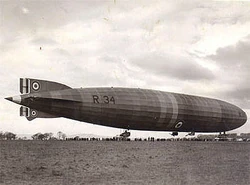Airships are Lighter than Air Aircraft that fly by using a "lifting gas" that is lighter than the atmosphere surrounding the ship. Also know as Dirigibles, These wonders of the sky could reach up to 800 feet in length.Unlike aerodynamic vehicles such as fixed-wing aircraft and helicopters which stay aloft by moving an airfoil through the air in order to produce lift, aerostatic craft such as airships and balloons stay aloft by filling a large cavity with lighter than air gas.

The R34 preparing for flight
Airships were the first aircraft to make controlled, powered flight. They were widely used prior to the 1940's. Their use decreased over time as their capabilities were surpassed by those of airplanes. A series of high-profile accidents, including the 1937 burning of the hydrogen-filled Hindenburg at Lakehurst, New Jersey, furthered their decline. Airships are still used today in certain niche applications however, including advertising and sightseeing.n many countries, airships are also known as dirigibles from the French dirigeable, meaning "steerable." The first airships were called dirigible balloons. Over time, the word balloon was dropped from the phrase. In the modern usage, balloon refers to buoyant aircraft that generally rely on wind currents for movement, though vertical movement can be controlled in both.
The term zeppelin is a genericised trademark that originally referred to airships manufactured by the Zeppelin Company. Their crafts' names were usually prefixed with the word Luftschiff, German for "airship".
In modern common usage, the terms zeppelin, dirigible and airship are used interchangeably for any type of rigid airship, with the terms blimp or airship alone used to describe non-rigid airships. Although the blimp also qualifies as a "dirigible", the term is seldom used with blimps. In modern technical usage, airship is the term used for all aircraft of this type, with zeppelin referring only to aircraft of that manufacture, and blimp referring only to non-rigid airships.
Types/Classifications[]
Rigid airships[]
(for example, Zeppelins) had rigid frames containing multiple, non-pressurized gas cells or balloons to provide lift. Rigid airships did not depend on internal pressure to maintain their shape. Non-rigid airships (blimps) use a pressure level in excess of the surrounding air pressure in order to retain their shape.
Semi-rigid airships[]
like blimps, require internal pressure to maintain their shape, but have extended, usually articulated keel frames running along the bottom of the envelope to distribute suspension loads into the envelope and allow lower envelope pressures.
Metal-clad airships[]
had characteristics of both rigid and non-rigid airships, utilizing a very thin, airtight metal envelope, rather than the usual rubber-coated fabric envelope. Only two ships of this type, Schwarz's aluminum ship of 1897 and the ZMC-2, have been built to date.
Hybrid airship[]
Hybrid Airships are a general term for an aircraft that combines characteristics of heavier-than-air (airplane or helicopter) and lighter than air technology. Examples include helicopter/airship hybrids intended for heavy lift applications and dynamic lift airships intended for long-range cruising. It should be noted that most airships, when fully loaded with cargo and fuel, are typically heavier than air, and thus must use their propulsion system and shape to generate aerodynamic lift, necessary to stay aloft; technically making them hybrid airships. However, the term "hybrid airship" refers to craft that obtain a significant portion of their lift from aerodynamic lift and often require substantial take-off rolls before becoming airborne.
Blimp[]
also known as Non-rigid airships, blimps use a pressure level in excess of the surrounding air pressure in order to retain their shape. Blimps, Semi-rigid, and Hybrid airships are the only types used today